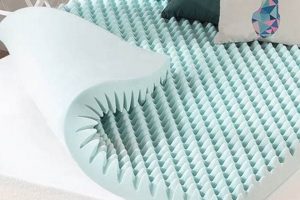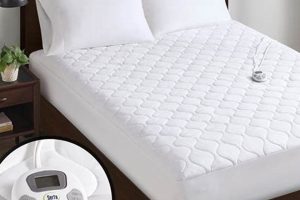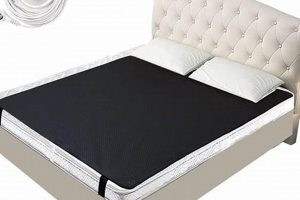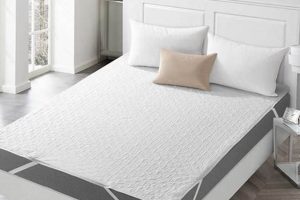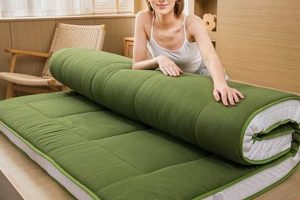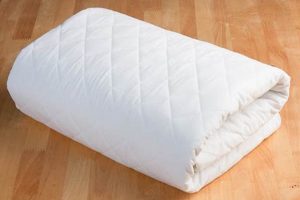A low-voltage warming system designed for placement on a bed, under the fitted sheet, provides supplemental heat to the user. Operating on a 12-volt power source, it offers a degree of safety and energy efficiency not typically found in standard household electric blankets or pads. A common application is in environments where standard AC power is limited or unavailable, such as recreational vehicles or camping scenarios.
The utilization of a safe, low-voltage power supply offers enhanced safety benefits, mitigating the risk of electrical shock commonly associated with mains-powered heating devices. Furthermore, power consumption is generally lower compared to standard electric blankets, making it a suitable option for off-grid power systems or situations where conserving energy is paramount. Historically, such systems have gained traction in mobile living and outdoor pursuits, addressing the need for comfort in variable temperature conditions.
The ensuing discussion will delve into the specifics of its construction, advantages, suitability for various applications, safety considerations, and crucial factors to consider when selecting the optimal solution for individual needs. Subsequent sections will explore power sources and options to use them efficiently.
Essential Usage Considerations
The following guidelines serve to maximize the effectiveness and longevity of the device, while prioritizing user safety and comfort.
Tip 1: Pre-Heating Protocol: Allow sufficient time for pre-heating the pad before retiring to bed. A period of 30-60 minutes is generally adequate to achieve a comfortable sleeping temperature.
Tip 2: Temperature Regulation: Utilize the available temperature settings judiciously. Start with a low setting and incrementally increase the heat as needed. Avoid excessively high temperatures for extended periods.
Tip 3: Secure Placement: Ensure the pad is positioned correctly beneath the fitted sheet, without creases or folds. Uneven distribution can lead to localized overheating and potential damage.
Tip 4: Power Source Compatibility: Verify the electrical compatibility of the power source. Using an incompatible power supply can result in malfunction or irreparable damage to the system.
Tip 5: Regular Inspection: Conduct routine inspections for any signs of wear, fraying, or damage to the wiring. Discontinue use immediately if any anomalies are detected.
Tip 6: Proper Storage: When not in use, store the pad in a cool, dry location, avoiding direct sunlight and moisture. Folding it loosely will prevent damage to the internal wiring.
Tip 7: Cleaning Precautions: Adhere strictly to the manufacturer’s cleaning instructions. Do not immerse the pad in water unless specifically indicated as safe. Ensure the pad is completely dry before reuse.
Adherence to these guidelines promotes safe and efficient operation, ensuring user comfort and extending the lifespan of the heating system. Prioritizing responsible usage is crucial.
The subsequent section will provide a comprehensive overview of the various power options. It will also include tips to optimize efficiency.
1. Power Source Stability
Power source stability is a foundational element for the reliable operation of any 12v warming system. Consistent voltage delivery directly impacts the performance, safety, and longevity of the device. Fluctuations or interruptions in power can compromise functionality and pose potential hazards.
- Consistent Heat Output
Stable voltage ensures uniform heat generation across the surface of the pad. Variations in power can lead to inconsistent heating, resulting in cold spots or localized overheating. This is particularly crucial for maintaining comfortable and safe sleeping temperatures. A voltage drop, even momentarily, can reduce the pad’s warming capabilities.
- Component Protection
The internal heating elements and control circuitry are designed to operate within a specific voltage range. Voltage spikes or surges can damage these components, leading to premature failure. Surge protection mechanisms in the power supply unit are therefore important in safeguarding the integrity of the system.
- Safety Compliance
Regulatory safety standards mandate that electrical devices maintain stable performance within defined voltage parameters. Instability can result in non-compliance with these standards, potentially voiding certifications and creating safety risks. A reliable power source ensures that the device operates within acceptable safety margins.
- Extended Lifespan
Consistent power delivery minimizes stress on the internal components, extending the operational lifespan of the warming system. Frequent voltage fluctuations can accelerate wear and tear, requiring more frequent replacements. A stable power supply contributes to the long-term cost-effectiveness of the 12v heated pad.
These facets underscore the importance of a stable power source for optimal functionality. Whether operating from a vehicle’s electrical system, a portable power station, or a dedicated AC adapter, ensuring a consistent and clean power supply is crucial for a comfortable, safe, and long-lasting experience. Neglecting this aspect can lead to compromised performance and increased risk of failure.
2. Temperature Control Precision
Temperature control precision is paramount in a 12v warming system, directly impacting user comfort, safety, and energy efficiency. Accurate and responsive thermal management ensures the device maintains a stable and desirable temperature range, optimizing the sleeping experience.
- Thermostat Calibration
The accuracy of the thermostat directly affects the temperature achieved. A poorly calibrated thermostat may indicate one temperature while the actual pad temperature deviates significantly. Calibration ensures the user-selected setting corresponds accurately to the warmth produced.
- Heating Element Responsiveness
The heating element’s responsiveness to temperature adjustments is critical. A highly responsive element will quickly adjust its output to match the desired setting, preventing overshooting or undershooting the target temperature. This ensures a more consistent and comfortable sleeping environment. Responsiveness is particularly important in fluctuating ambient temperatures.
- Feedback Loop Integration
Sophisticated systems incorporate a feedback loop, continuously monitoring the pad’s temperature and adjusting the heating element output accordingly. This feedback mechanism ensures stable temperature maintenance despite external influences, such as changes in room tempera
ture or body heat. A closed-loop system offers greater accuracy and efficiency. - Zonal Temperature Control
Advanced models may feature zonal temperature control, allowing users to independently adjust the heat level in different sections of the pad. This provides personalized comfort options, catering to individual preferences or accommodating varying temperature needs across different body regions. Zonal control enhances overall user satisfaction.
Temperature control precision is a critical design parameter for 12v warming systems. Accurate calibration, responsive heating elements, feedback loop integration, and zonal control features contribute to enhanced user comfort, improved energy efficiency, and a safer sleeping environment. Compromises in this area can negatively impact the overall performance and satisfaction associated with the warming device. It is therefore essential to carefully assess these features when selecting a suitable 12v warming pad.
3. Material Safety Standards
Material Safety Standards are of paramount importance in the design and manufacture of 12v warming systems. Direct contact with the body necessitates rigorous adherence to established safety protocols to minimize potential health risks and ensure user well-being.
- Flame Retardancy
Textile materials used in the construction of warming pads must meet stringent flame retardancy standards. These standards dictate that the fabric should resist ignition and self-extinguish in the event of a fire. Common examples include compliance with UL 94 or similar flammability tests. This reduces the risk of fire hazards while the pad is in use. Failure to comply can lead to rapid flame spread, posing a direct threat to the user’s safety.
- Absence of Harmful Substances
The materials used must be free from hazardous chemicals such as lead, mercury, cadmium, and certain phthalates. These substances, if present, can leach out of the material over time, potentially causing adverse health effects through skin contact or inhalation. Compliance with standards like RoHS (Restriction of Hazardous Substances) is crucial to ensure consumer safety. Prolonged exposure to these chemicals can lead to various health complications, underscoring the need for certified materials.
- Electrical Insulation Integrity
The insulation surrounding the electrical components, including the heating wires, must meet specific dielectric strength requirements. This ensures that the electrical current remains contained within the wires and does not pose a risk of electric shock to the user. Standards such as IEC 60335 dictate the minimum insulation resistance and withstand voltage. Degradation of the insulation can lead to current leakage and potential electrocution hazards.
- Biocompatibility
Materials in direct contact with the skin should exhibit biocompatibility, meaning they should not cause allergic reactions, skin irritation, or other adverse dermatological effects. Materials are typically tested for sensitization and irritation potential according to standards like ISO 10993. Selecting biocompatible materials minimizes the risk of skin problems and ensures user comfort during extended use.
Compliance with material safety standards is not merely a regulatory requirement but a fundamental aspect of responsible product design and manufacturing. The incorporation of flame-retardant fabrics, the elimination of harmful substances, the maintenance of electrical insulation integrity, and the utilization of biocompatible materials are all crucial measures to safeguard user health and well-being when using 12v warming systems. Scrutinizing product certifications and material specifications is essential in ensuring a safe and comfortable user experience.
4. Even Heat Distribution
Even heat distribution represents a critical performance parameter for 12v warming systems designed for placement on a mattress. The effectiveness of such a system is directly correlated with its capacity to deliver consistent and uniform warmth across its entire surface area, thereby optimizing user comfort and minimizing localized temperature extremes.
- Heating Element Configuration
The arrangement and density of the internal heating elements directly influence heat distribution. Closely spaced elements, strategically positioned across the pad’s surface, promote uniform warming. Sparsely populated or unevenly distributed elements can result in inconsistent temperature profiles, creating cold spots or localized overheating. The wiring layout should minimize areas of concentrated heat, avoiding potential discomfort and reducing the risk of material degradation. This approach will give user ultimate experience and prevent hazard in case of defect.
- Material Conductivity Properties
The materials utilized in the construction of the warming pad influence the lateral transfer of heat. Fabrics with high thermal conductivity facilitate the spread of warmth, mitigating temperature gradients. Materials with low conductivity, conversely, impede heat transfer, potentially leading to localized temperature variations. The selection of appropriate materials is crucial in achieving a homogenous thermal output. By this conductivity, power loss of the heat can be reduce and maintain the same heating value in every parts.
- Control System Algorithms
Advanced control systems employ algorithms to monitor and regulate temperature output across different zones of the pad. These algorithms can compensate for variations in heat loss due to external factors, such as uneven contact with the user’s body or variations in ambient temperature. Sophisticated feedback mechanisms enable the system to dynamically adjust power delivery to maintain a consistent and uniform thermal profile. This is crucial to meet specification value of temperature that can make sure for safety.
- Layered Construction Techniques
The layering of different materials within the warming pad’s construction can contribute to enhanced heat distribution. For instance, a layer of thermally conductive material beneath the heating elements can facilitate the spreading of warmth before it reaches the user’s body. Conversely, a layer of insulating material on the bottom of the pad can minimize heat loss to the mattress, directing more heat upwards towards the user. Layered construction represents a refined approach to thermal management.
The efficacy of a 12v warming system is inextricably linked to its ability to provide even heat distribution. This is achieved through careful consideration of heating element configuration, material conductivity properties, control system algorithms, and layered construction techniques. These engineering parameters collectively determine the thermal performance of the pad and directly impact the user’s experience. Inadequate attention to these factors can result in diminished comfort, reduced energy efficiency, and potential safety concerns, highlighting the importance of comprehensive thermal design.
5. Durability Over Time
The extended operational life of a 12v warming system is a crucial factor in assessing its overall value. A lack of durability translates to frequent replacements, increased costs, and potential inconvenience. The capacity of the device to withstand prolonged use, often in demanding environments such as recreational vehicles or camping scenarios, directly impacts its practicality and long-term economic viability. For example, a pad used regularly in a truck during cross-country hauls is subject to constant vibration and temperature fluctuations, placing considerable stress on its internal components and materials.
Several factors contribute to the durability of these systems. The quality of the heating elements is paramount; inferior elements are prone to breakage, corrosion, or burnout after limited use. The robustness of the wiring and its connections is equally important, as these components are subjected to repeated flexing and stress. Material degradation due to prolonged exposure to sunlight, moisture, or temperature extremes can also significantly shorten the lifespan of the pad. A system that fails after a single season of use represents a poor investment, regardless of its initial cost. A design that incorporates high-quality materials, reinforced wiring, and protective measures against environmental factors offers greater longevity and minimizes the risk of premature failure. For instance, using water-resistant fabrics and sealed connectors protects against moisture damage in humid conditions.
The understanding of the link between durability and a 12v warming system’s construction has practical significance for both manufacturers and consumers. Manufacturers who prioritize the use of durable components and robust designs can establish a reputation for quality and reliability. Consumers who consider durability as a key selection criterion can avoid the costs and inconveniences associated with frequent replacements. Ultimately, an emphasis on durability ensures a more sustainable and cost-effective solution for supplemental heating needs, contributing to greater customer satisfaction and a reduced environmental footprint. The implementation of rigorous testing protocols to simulate extended use and environmental stress serves to validate the durability claims made by manufacturers, providing consumers with greater confidence in their purchasing decisions.
Frequently Asked Questions Regarding 12v Heated Mattress Pads
The following section addresses common inquiries and misconceptions concerning 12v warming systems. The information provided aims to offer clarity and enhance understanding of the device’s capabilities and limitations.
Question 1: What is the typical power consumption of a 12v heated mattress pad?
Power consumption varies depending on the pad’s size, heating element density, and selected temperature setting. However, a typical draw ranges from 3 to 6 amps, equating to 36 to 72 watts at 12 volts. Consult the manufacturer’s specifications for precise power requirements.
Question 2: Is a 12v heated mattress pad safe for continuous overnight use?
While generally safe, precautions should be observed. Overheating or prolonged use at high settings can lead to discomfort or, in rare cases, pose a fire hazard. It is advisable to utilize temperature control features responsibly and conduct routine inspections for any signs of damage.
Question 3: Can a 12v heated mattress pad be used with any type of mattress?
The pads are compatible with most standard mattress types, including innerspring, memory foam, and latex. However, it is essential to ensure the pad lies flat and without creases, as this can affect heat distribution and potentially damage the heating elements. Follow the manufacturer instructions for compatibility.
Question 4: How is a 12v heated mattress pad cleaned?
Cleaning procedures vary depending on the specific model. Many pads feature removable covers that can be machine-washed. Immersion of the heating element itself is generally discouraged unless specifically indicated by the manufacturer. Always consult and adhere to the provided cleaning instructions.
Question 5: What type of power source is required for a 12v heated mattress pad?
The pad necessitates a 12-volt DC power source. This can be derived from a vehicle’s battery, a portable power station, or a dedicated AC-to-DC power adapter. Ensure the power source is capable of providing sufficient amperage to meet the pad’s power demands.
Question 6: How does a 12v heated mattress pad compare to a standard AC electric blanket in terms of safety?
Due to the lower voltage, 12v systems typically present a reduced risk of electrical shock compared to standard AC electric blankets. However, proper usage and maintenance are still essential to mitigate any potential hazards. The systems are generally safe.
The information provided clarifies the capabilities, safe usage, and maintenance of 12v heated mattress pads. Responsible operation and adherence to manufacturer guidelines are crucial for optimal performance and user safety.
The following section will delve into specific scenarios where the pads are frequently deployed and include real-world use cases and associated benefits.
Conclusion
The preceding discussion has explored the multifaceted aspects of the 12v heated mattress pad, encompassing its design, functionality, safety parameters, and practical considerations. The analysis has underscored the importance of power source stability, temperature control precision, adherence to material safety standards, uniform heat distribution, and long-term durability as key factors influencing the overall performance and user experience.
Understanding these critical attributes empowers informed decision-making in the selection and responsible utilization of such devices. As technology advances, continued refinements in design and safety protocols will further enhance the benefits and broaden the applicability of 12v heated mattress pad solutions across diverse environments, thereby addressing evolving needs for personalized comfort and thermal regulation. It is a system that blends safety and comfort.


